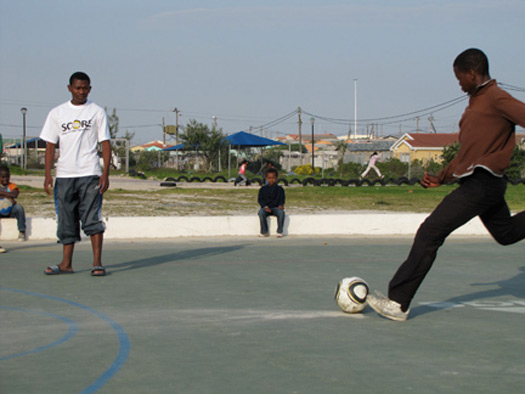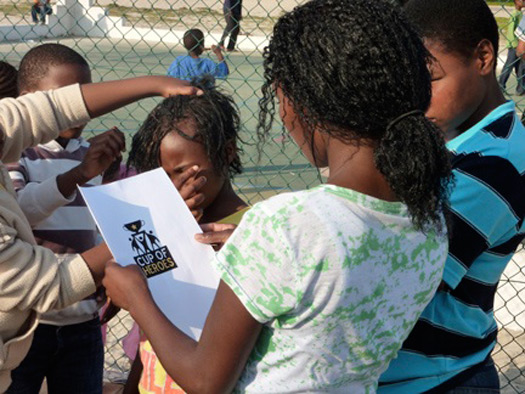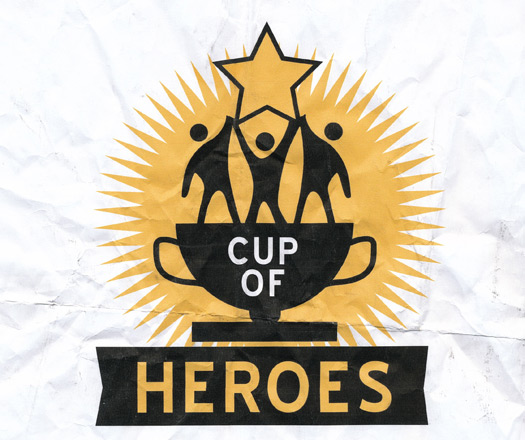
Cup of Heroes

View of Khayelitsha from Lookout Point, Capetown Flats, 2010. Photos: Jen Roos
Earlier this month, with World Cup 2010 underway in downtown Cape Town, two friends and I searched the backstreets of Khayelitsha, the city’s largest marginalized township.
We were hoping to find Siyolo Mdikili, Ndzuzo Mrawuzeli and Lindile Mgcoki, three of the under-12 soccer players we had befriended in the early ‘90s when our paths intersected on Khayelitsha’s sandy elementary-school fields.
With reliable avenues for communication (mail service, cell phones, internet) emerging only slowly in Khayelitsha over the past 18 years, it has been nearly impossible for us to stay in touch. Luckily, as we searched through rows of homes with children running alongside our van, neighbors and relatives were able to help us reconnect with all three boys, now men.
In 1992 Siyolo, Ndzuzo and Lindile had been young captains of the fledgling school soccer teams we helped organize through SCORE, one of Cape Town’s longest-running, township-based community development programs. SCORE was founded in 1991 in the belief that the life skills children develop on playing fields will translate into leadership roles within their communities.

Soccer game on one of the township’s cement playing fields
Over the years each of these boys had worked hard and struggled to get by. Siyolo sold what little furniture he had to pay for studies in sports management at the University of Cape Town, recently entering the program at the age of 30.
I had returned to Cape Town not just to seek out old friends, but also as part of my research into the relationship between design and sport. Through a grant from Mercy College in New York, where I teach graphic design, I was developing ideas about the values society communicates through sports imagery and infrastructure.
I was also there to assist SCORE in designing a logo for its annual Cup of Heroes awards program. In contrast to the ways in which worldwide sports marketing promotes professional athletes as heroes, SCORE’s program champions local athletes, like Siyolo, who are striving to become leaders in their communities. Cup of Heroes celebrates youth teams across southern Africa not just for their athletic prowess, but also for fair play and community service.

Children reviewing designs for SCORE’s Cup of Heroes logo
The Cup of Heroes logo was a group effort: ideas were generated with SCORE’s key management standing on either side of me at the computer. Once we had created a number of variations, the real selection process began. The children would choose.
So much in Khayelitsha remains disheartening. Main roads are paved now, but they continue to be lined with shacks progressing to what seems infinity. The poverty is so extensive and entrenched it feels like a blow. Yet incremental change can be detected.
From high up on Lookout Point (a massive sand dune in the Cape Town Flats), we could see what was invisible from the road: large areas in which concrete block housing was being built. Most every shack and shelter now has access to electricity and municipal garbage pickup, services that were unavailable in 1992. Across the road from Khayelitsha’s newly signed official entrance sit the recently constructed visitor center and community pool.
We also visited concrete recreational surfaces that SCORE is building to replace dusty soccer “fields,” and other emerging small-scale sport facilities, like the Khayelitsha Football for Hope Centre developed by Architecture for Humanity (the first of FIFA’s “20 Centers for 2010” and one of only four that have been built as of yet).
At every stop on this tour, I asked myself whether resources in a place of such profound deprivation were being allocated appropriately. It’s a question that has been raised ever since South Africa won the bid to host the 2010 World Cup. But many in Cape Town and Khayelitsha have taken pride in the new images of South Africa — spectacular arenas like Cape Town’s Green Point stadium, jubilant vuvuzela blowers, mobs of international spectators — images that have led a worldwide audience to think more about the culture of South Africa and less about kneejerk associations with hardship, disease and crime.

After rushing off with pages of logo sketches, the children returned with this crumpled solution, their “favorite”
And yet, in Khayelitsha, more than 1 million South Africans still struggle against apartheid-induced poverty. The townships are the true heartland of South African soccer. And although new soccer fields are slowly emerging, it seems discouraging that Khayelitsha Stadium is no different from what it was in 1992 — a dusty grass patchwork with skeletal bleachers.
Within minutes of arriving at Isiphiwo, the school in Khayelitsha where local soccer matches were underway, eight sheets of logo printouts were scattered across the playing surfaces. The children claimed individual pages and ran off with them. Eventually they returned triumphantly with one of the crumpled solutions.
This logo (depicting silhouetted figures standing atop a trophy, arms raised in triumph) was designated the favorite, but it might simply have been the one design no one chose to take home and keep. It was certainly the most literal solution. The children wanted to see clear images of themselves celebrating with the trophy they were striving so hard for.
On a raw concrete playing surface in Khayelitsha, this made perfect sense.
Observed
View all
Observed
By Jen Roos
Related Posts

Equity Observer
L’Oreal Thompson Payton|Essays
‘Misogynoir is a distraction’: Moya Bailey on why Kamala Harris (or any U.S. president) is not going to save us

Equity Observer
Ellen McGirt|Essays
I’m looking for a dad in finance

She the People
Aimee Allison|Audio
She the People with Aimee Allison, a new podcast from Design Observer

Equity Observer
Kevin Bethune|Essays
Oh My, AI
Related Posts

Equity Observer
L’Oreal Thompson Payton|Essays
‘Misogynoir is a distraction’: Moya Bailey on why Kamala Harris (or any U.S. president) is not going to save us

Equity Observer
Ellen McGirt|Essays
I’m looking for a dad in finance

She the People
Aimee Allison|Audio
She the People with Aimee Allison, a new podcast from Design Observer

Equity Observer
Kevin Bethune|Essays

